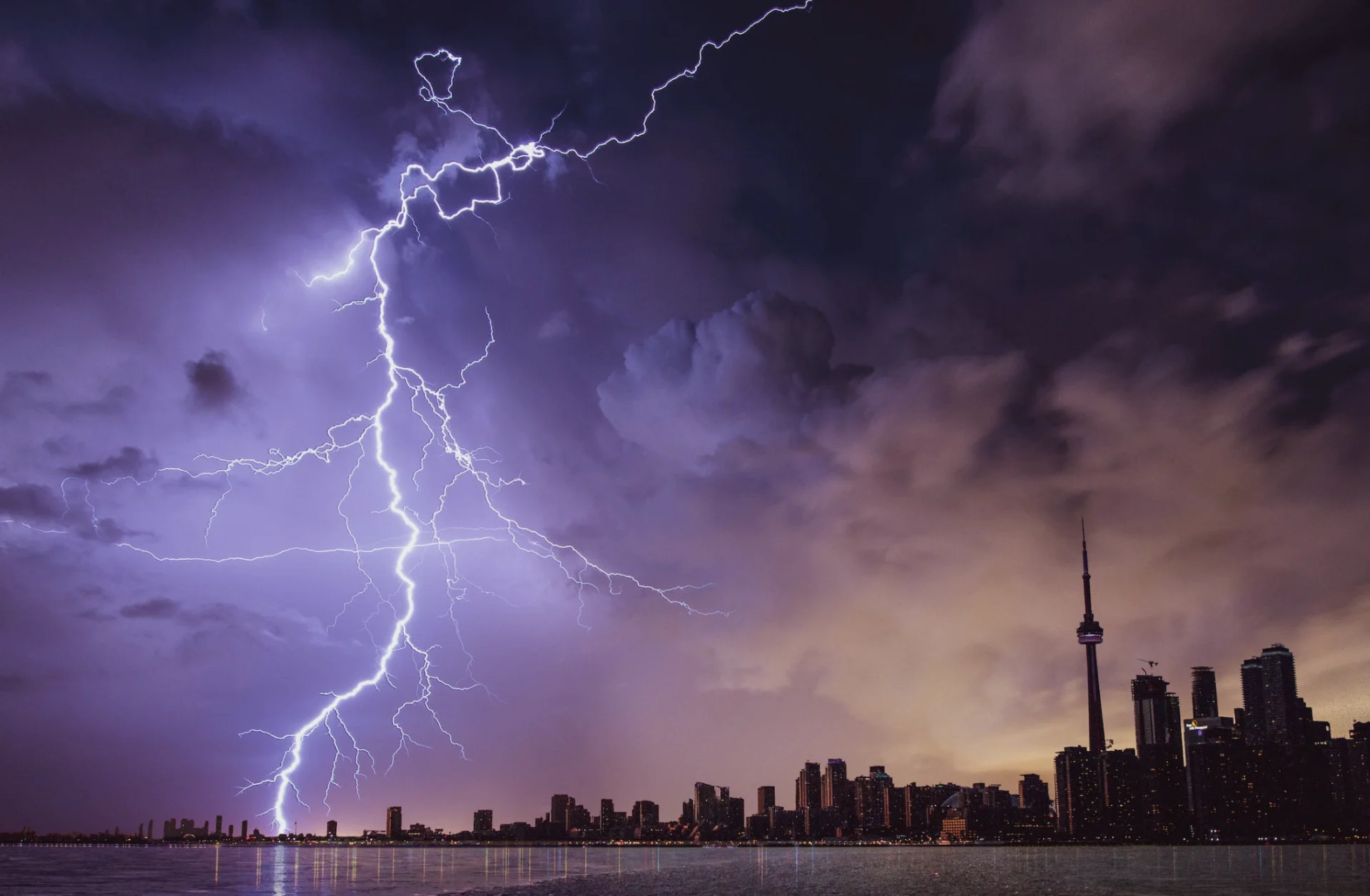
What really happens inside you when you're hit by lightning?
When thunder roars, go indoors. It's a reminder given anytime we see storms that produce lighting. The Weather Network's Mark Robinson explains why we should take the warning seriously and explains what happens when lightning strikes a human.
You’ll never hear the one that gets you.
This was the saying playing in my head as I attempted my best imitation of a gopher on energy drinks while simultaneously clapping both hands over my ears. I didn’t have time to jump back into The Weather Network (TWN) vehicle, so getting underneath was the only course of action open to me.
The crackle of a step leader is a weird noise because it sounds just like an exploding electrical transformer with lots of sizzling and popping. The only good thing about the sound is that it gave me about one second’s warning that I was about to be ground zero for a lightning strike.
The storm was about 20 kilometres to my north, and I’d stepped out of the TWN car to set up my camera to capture some night lighting when the storm decided to give me a very, very up-close and personal lesson of what lightning can do.
When you’re that close to a cloud to ground strike, there’s no rumble of thunder, no flash, and then a delay for the sound. All there is is a flash and the loudest bang you’ve ever experienced, all happening at once. We storm chasers call it a "flang" (the flash and the bang happen at the same time), and it’s part of the biggest danger (outside of driving) that chasers face.
Lighting.
Lighting is a complicated phenomenon, and given that the planet is struck by 8.6 million lightning bolts per day, it’s inevitable that people will be struck. Given that I’ve spent a lot of time under thunderstorms and I’ve had more than one close call, I decided that I’d better get some information about what exactly happens when the human body is hit.

I called up my friend and fellow storm chaser, Dr. Jason Persoff, the Assistant Director of Emergency Preparedness at the University of Colorado Hospital in Denver. He’s dealt with lightning strike victims in the past, and given his solid understanding of meteorology, he’s uniquely qualified to explain to me why getting hit is a very bad thing.
"First up, you have to understand that there are two different types of lightning strikes when you’re talking about the human body: positive and negative," he explained. "Positive strikes are far more powerful of the two, and generally, if you’re hit by one of those, there’s only one outcome: death. On the other hand, negative strikes are less powerful but [still move] an incredible amount of energy."
WATCH: Lightning safety tips you should know and be able to share
RELATED: 10 fast facts about lightning
I mentioned that I didn’t think either one was good, but I knew that getting struck directly didn’t happen all that often. I’d seen lots of videos of people falling over, seemingly dead, even when the strike could be seen hitting a tree nearby.
"It turns out that the ground is actually not a good ground for electricity," he continued. "When the lightning strike hits the ground, it isn’t just magically absorbed. In fact, when it hits, it’s a lot like spilling a glass of water on the ground. It will hit and then spread out in a circular area. So, you get this area of splash effect from the strike point. This is relevant because it means that people standing near the strike point can be struck by the lightning. There’s a phenomenon called ‘step current’ that can occur; when someone has one foot closer to the lighting strike than the other one, the electricity can travel up one leg, go through the pelvis, and down the other leg before exiting the body. The charge can get as high as the heart, and that can cause a sudden cardiac arrest."
I pointed out that I’d never had a heart attack when I’d accidentally stuck my finger in a wall socket, but I also knew that house electrical current didn’t pack quite the wallop that lightning did.
"If we’re talking about the heart itself, I like to tell my patients that there are two systems in the heart, one mechanical and one electrical," said Persoff. "Mess up the electrical system, and the mechanical won’t work either. So, in a lightning strike victim, the electrical system is overloaded, and the heart just stops and then goes into an irregular, chaotic pattern we call ventricular fibrillation. This is why people who are struck by lightning need high-quality chest compressions immediately to try and resume the heart. Incredibly, that will usually work really well; just doing chest compressions."
That sounds good, but there’s a bit more to it. Survival isn’t the end of being struck.
"About three-quarters of people survive being struck. But lightning never leaves a person unharmed," Persoff explained. "The amount of electrical activity that comprises a human system gets overcharged to the point of it being ‘surged’. So, people will routinely develop cataracts; they will lose hearing from the thunder, which, up close, is an explosive sound, as well as the electricity entering the ear canal. People will also develop permanent nerve damage; almost universally, people will develop tingling or pain along the nerve fibres that were involved. Finally, people can have what we call 'Lichtenberg figures' on the body. These are small capillaries that are broken apart along the path of the lightning through the body. These resemble the forked look of the lighting itself and can be quite, if you’ll pardon the expression, striking."
"The biggest thing about being struck is that you will end up permanently scarred, so lightning is something to be avoided as much as possible."
I’d gotten very lucky that night on the road near Goderich, Ontario. The lightning bolt hit the electrical pole beside me instead of the top of my head. All I had to deal with that night was a knocked-over camera and somewhat messed-up pants instead of permanent injuries.
In case you’re wondering, yes, I’d learned my lesson. Don’t shoot lightning if you’re standing outside, even if you think the storm is far away. Getting the shot using a remote trigger while sitting inside a warm, dry car is the way to go, and if you’re not me, heed the old saying:
When thunder roars, go indoors.
WATCH: When lightning strikes! Understanding the dangers of severe weather
Header image credit: Pexels/Andre Furtado










